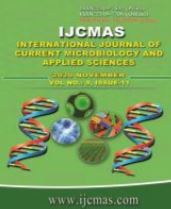


 National Academy of Agricultural Sciences (NAAS)
National Academy of Agricultural Sciences (NAAS)

|
PRINT ISSN : 2319-7692
Online ISSN : 2319-7706 Issues : 12 per year Publisher : Excellent Publishers Email : editorijcmas@gmail.com / submit@ijcmas.com Editor-in-chief: Dr.M.Prakash Index Copernicus ICV 2018: 95.39 NAAS RATING 2020: 5.38 |
Cowpea [Vigna unguiculata (L.) Walp.] is a legume whose immature pods are consumed and marketed. However, it suffers yield losses due to attacks of aphid-transmitted mosaic disease. The present work is a study of the genetic resistance of twelve (12) varieties of vegetable cowpea to Cowpea Aphid-Borne Mosaic Virus (CABMV) at Kamboinsé. The objective of the study was to contribute to the enhancement and improvement of yields through the development of vegetable cowpea varieties resistant to CABMV. The study was conducted in a screen house at Kamboinsé research station using a randomized complete block design with three (3) replications, all inoculated with CABMV. The study showed the existence of a large genetic variability within the varieties studied. The analysis of variance showed very highly significant differences (P=0.0001) between the twelve (12) vegetable cowpea varieties in terms of symptom severity. Principal Component Analysis (PCA) of the variables revealed the parameters that discriminate between varieties. High correlations levels were observed between several variables. The vegetable cowpea varieties IT85F-2089-5, IT85F-2082 and Telma which had low severity values (1 and 2), the area under disease progress curve (AUDPC) and a high weight of one hundred seed have been identified as the best varieties of vegetable cowpea. The variety IT85F-2089-5 have been identified as an elite variety because of a low severity (1), early flowering date (40 days), early green cowpea date (51 days), early maturity date (57 days) and a low value for the AUDPC (9). These varieties can thus contribute to the improvement of vegetable cowpea production by producers in Burkina Faso.
 |
 |
 |
 |
 |